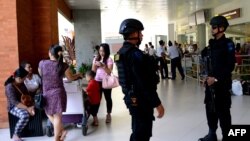As the Indonesian government and security services celebrate the killing of the country’s most notorious terrorist, experts say there is still much work to do on the country’s soft approach to combating radical Islam.
While direct action against terrorists has gotten a boost, analysts warn the risk of recruitment remains unchanged.
“We don’t have much of a budget or facility for the ‘soft approaches’ like a de-radicalization program at the micro, individual level, at the group level and also in the macro, societal level,” said Hamdi Muluk, a psychology professor and terrorism expert at the University of Indonesia in Depok, West Java. “It’s this approach that can prevent future radicalization.”
Perhaps the most resounding failure of the government’s de-radicalization efforts is Santoso himself, the terrorist leader who died in a gun battle last month in central Sulawesi. He underwent a de-radicalization program while imprisoned in 2010.
Santoso
Santoso, also known as Abu Wardah, had been a thorn in Indonesia’s side for years. He originated as a jihadist figure during Muslim-Christian violence in Sulawesi in the period of instability following the fall of longtime Indonesian strongman Suharto.
He went on to entrench himself in the impenetrable jungles of central Sulawesi, emerging as the leader of the East Indonesia Mujahidin in 2012 and declaring for the Islamic State, or IS, in 2014 — an effective public relations move that focused attention on his guerrilla band.
The actions of his network in Central Sulawesi had already been making regular headlines as it clashed with security forces chasing him around Poso, his Central Sulawesi stronghold. After his IS pledge, that coverage became almost weekly on Indonesian TV networks, websites and newspaper pages.
It raised the heat on the government to kill or capture him.
“I think Santoso’s death will have a positive impact on Indonesia’s image in the eyes of the region and globally,” said Muluk. “It would disaffirm (the notion) that Indonesian counter-terror forces, in this case the Tinombala task force, are incapable of chasing, capturing or destroying terrorist actors [including] the most prominent ones today, like Santoso.”
But that is guarded optimism.
Muluk also said “there was no evidence that the recruitment for ISIS ended” with Santoso’s death.
Muluk is not alone in this concern.
“We need more effort beyond conventional strategic programs,” said Fajar Riza Ul Haq, executive director of the Maarif Institute, an NGO with close ties to one of Indonesia’s largest Muslim groups, Muhammadiyah. “Our enemy is a step ahead.”
Online engagement
Indonesia has had relatively few IS fighters for a country of its size. Most estimates put the number in the hundreds, a surprisingly low tally given the country has the world’s biggest Muslim population. Experts cite the relative stability of the country and a generally more moderate practice of Islam.
But a problem facing authorities is the increasing online savviness of terrorist groups and Indonesia’s huge proportion of young people, who are some of the most engaged online users in the world.
This means access to vulnerable people is much simpler than it would have been before the digital age, and small, fragmented urban cells pose a greater threat of radicalization than a guerrilla group in a remote area.
Radicalization remains a threat, however large the symbolic importance of Santoso’s death.
“Santoso’s death is not an ending,” said Ul Haq, “The state must work together with religious-based organizations … At the same time, the government must ensure religious-based organizations take this issue really seriously.”
Succession
“His cell might be shrinking, but doesn’t mean the end at all,” Muluk said. “They may be trying to find the new Santoso.”
There is a candidate to replace Santoso as the public figurehead of Indonesian terrorists.
Amman Abdurahman, imprisoned at the infamous Pasir Putih jail, is a likely candidate. He has followers in another remote part of eastern Indonesia, a small district called Bima on the rugged and beautiful island of Sumbawa in West Nusa Tenggara province. The Bima gang, according to Muluk, still takes its orders from their jailed leader.
Santoso’s second wife was from Bima, and the “Bima gang” are, in Muluk’s words, “bound” by the same Salafist ideology, and an act of revenge for Santoso’s killing if it comes from anywhere is likely to come from there.









